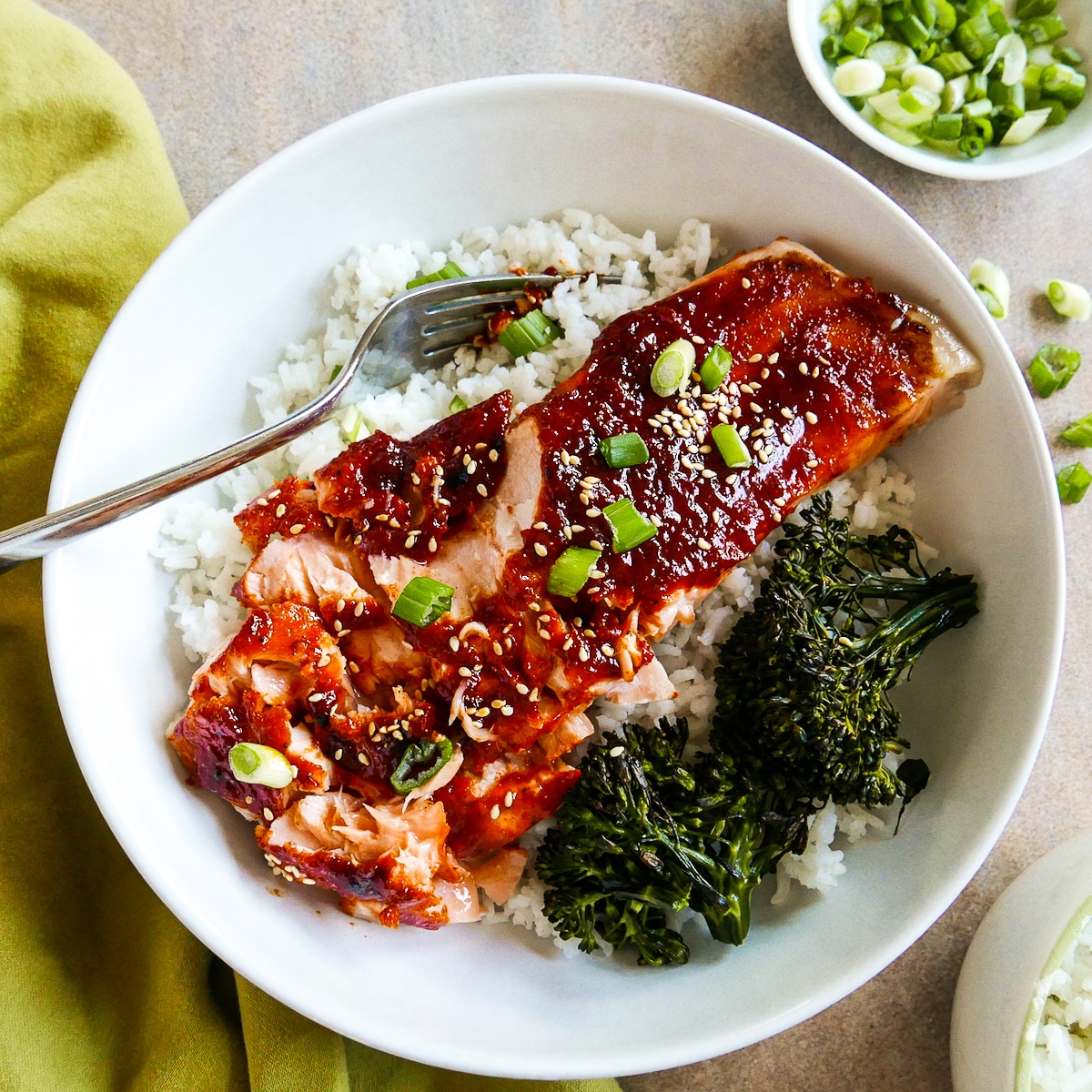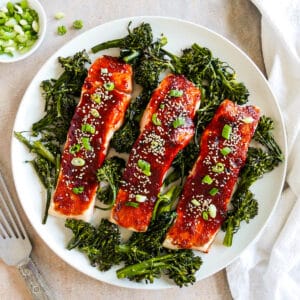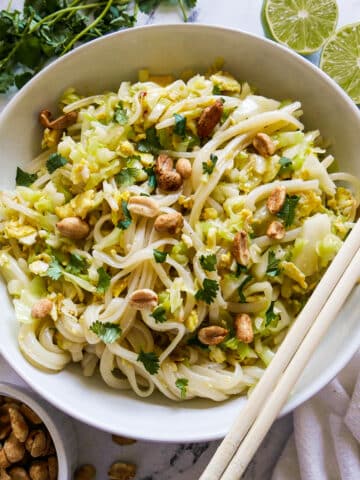If you've got 20 minutes, this gochujang salmon recipe is going to knock your socks off with bold flavor. The spicy-sweet-savory glaze is quick & easy, despite this being an elegant and impressive dish. Serve it with rice or noodles for a healthy & satisfying weeknight meal.

Want to save this recipe?
Enter your email below and get it sent straight to your inbox. Plus, I'll send you easy and delicious recipes every week!
I make salmon frequently on busy weeknights. It's so easy, protein-rich, and there's so many different ways to prepare it, like my miso butter salmon, spinach stuffed salmon, and mustard dill salmon.
But this gochujang glazed salmon is one of my favorite ways to enjoy salmon. It has deep savory flavor with subtle spicy-sweet notes.
And a hot tip? I keep frozen salmon fillets in my freezer, which both saves money and prevents me from having to go to the grocery store every few days. 😉
Jump to:
⭐️ Why This Salmon is the Best
- Easy Korean salmon recipe that's ready in just 20 minutes
- Tender, flaky salmon is paired with a spicy-sweet-savory glaze for a hearty and satisfying dish
- Quick and delicious weeknight dinner that looks elegant & impressive
- Healthy recipe that's high in protein, omega-3 fatty acids, nutrient-rich & dairy-free
- 3 cooking options provided (broiled, oven-baked, and air fryer)
- Use the gochujang glaze on pasta, meatballs, roasted carrots & green beans, or other fish dishes
💬 What is Gochujang?
Gochujang is a fermented Korean spicy-sweet chili paste made from fermented soybeans, red chili peppers, rice, and salt.
It's a bold-flavored condiment that is deeply savory, spicy, and sweet, with slightly funky notes. Gochujang is used in a variety of Korean dishes, including bibimbop, tteokbokki, soups, and salads.
Compared to other condiments, gochujang is a healthy alternative, as it's low in sugar and its fermented properties make it good for gut health.
🐟 Ingredient Notes

- Gochujang (Korean chili paste) - Gochujang is a fermented Korean spicy-sweet chili paste made from fermented soybeans, red chili peppers, rice, and salt. Make sure that you are using the paste and not the sauce, which is a different product. It can usually be found in the Asian section of your local supermarket.
- Garlic powder - I recommend using garlic powder here since fresh garlic will burn easily under the broiler.
- Fresh ginger - Dried ginger will work as well, but I recommend using fresh ginger for optimal flavor.
- Low-sodium soy sauce - I always use low-sodium soy sauce, which lets me control the amount of sodium in my cooking. If you only have regular soy sauce on hand, skip the additional salt.
- Honey - Use your favorite brand of honey, or substitute maple syrup or brown sugar for a similar flavor.
- Rice wine vinegar - You can substitute white wine vinegar or apple cider vinegar for similar results.
- Sesame oil - With deep umami flavor, a little bit goes a long way!
- Salmon fillets - Purchase a thicker whole fillet of salmon or pre-sliced 4-6 ounce pieces that are of similar size so they cook evenly; you can use skin-on or skinless salmon.
- Scallions - Adds fresh & slightly spicy flavor
- Toasted sesame seeds - These are completely optional, but they lend the gochujang salmon a nice nutty flavor and give it a delicate crunch.
📝 Variations & Substitutions
- Make gluten-free: Substitute gluten-free gochujang & use tamari in place of soy sauce
- For baked salmon: Preheat your oven to 400 degrees F. Transfer prepared salmon fillets to a lightly greased baking dish. Bake for 10-15 minutes (depending on how large your fillets are), until salmon is cooked through with an opaque center. Salmon thickness varies, but aim for 4 to 6 minutes per half-inch of thickness. You could also use an instant-read thermometer to check for doneness. The USDA recommends a minimum internal temperature of 145 degrees F. at the thickest part of the fillet.
- In air fryer: Preheat your air fryer to 380 degrees F. Place prepared salmon fillets in air fryer and cook for 10-12 minutes, until salmon is cooked through with an opaque center.
🔪 How to Make Gochujang Salmon
Preheat broiler and place the oven rack 6-8 inches away from broiler. Pat salmon dry using a paper towel. Line a baking sheet with foil and transfer salmon (skin side down) to prepared baking sheet.

In a small bowl, whisk together the gochujang paste, fresh ginger, garlic powder, soy sauce, honey, rice wine vinegar, sesame oil, salt, and pepper.

Use a pastry brush or the back of a spoon to glaze salmon with gochujang sauce.

Broil salmon for 5-7 minutes, rotating pan halfway through. Keep an eye on it. If it starts to burn or smoke, move it to a lower rack.
Let gochujang salmon rest for 5 minutes before serving. Garnish with scallions and sesame seeds. Serve with rice, noodles, or your favorite vegetable.

👩🏼🍳 Expert Tips
- Storage: Place in an airtight container and store in the fridge for up to 4 days.
- How to freeze: After completely cooled, transfer salmon to a freezer-safe container and freeze for up to 3 months. To thaw, place in refrigerator overnight.
- How to reheat: Cover loosely with foil and place salmon in a preheated 300 degree F. oven for 15 minutes, or until heated through. For more reheating methods, read my post on how to reheat salmon!
- Don't overbake (if baking in oven). Salmon thickness varies, but aim for 4 to 6 minutes per half-inch of thickness. You could also use an instant-read thermometer to check for doneness. The USDA recommends a minimum internal temperature of 145 degrees F. at the thickest part of the fillet.
- Buy frozen salmon fillets. Buying frozen fillets is an easy way to save money, and you can always have salmon on hand this way.
- Use low-sodium soy sauce. This is an easy way to control your sodium intake. If you only have regular soy sauce on hand, skip the additional salt.
- Line baking sheet with parchment paper or foil for easy clean up.
- Salmon skin on or off. This is totally up to you, but leaving the skin on will add flavor to your salmon and help to prevent it from drying out when cooked.
🍽 How to Serve Gochujang Salmon
This deeply savory and slightly spicy-sweet gochujang fish recipe pairs well with a variety of dishes, from potatoes, vegetables, and salads, to a bowl of noodles. Here are some of my favorite ways to serve it:
- Pair it with roasted vegetables, like Brussels sprouts, broccoli, or roasted carrots and green beans
- Serve it with a light side salad, like apple cucumber salad
- Serve it on a bed of rice or noodles, or pair it with miso noodles
- Accompany it with a side of potatoes, like red skin mashed potatoes

💬 Frequently Asked Questions
The beauty of salmon is that is pairs with almost any flavor. Because of its high fat content, creating a glaze or sauce that contains acidity, sweetness, or both, helps to balance the rich flavor.
Gochujang can be added to a recipe whenever you are looking for a spicy-sweet bold flavor. Turn it into a glaze for any type of meat, add a dollop to soups and stews, or add a light drizzle to noodles or rice for extra flavor.
It's a traditional Korean spicy-sweet sauce made from fermented chili paste (gochujang), but with the added flavor of tomato paste, soy sauce, and some form of sugar. It's commonly used to make Korean fried chicken, and can be drizzled on vegetables or a bowl of noodles.
Compared to other condiments, gochujang is a healthy alternative, as it's low in sugar and its fermented properties make it good for gut health.
🐠 Related Recipes
Tried this recipe? Please leave a star ⭐️⭐️⭐️⭐️⭐️ rating below and/or a review in the comments section further down the page. You can also stay in touch with us through social media by following us on Instagram, Pinterest, TikTok, and Facebook.
Subscribe to my email newsletter to get a FREE e-book of 20 vegetarian recipes, and get new recipes delivered to your inbox every week!

Gochujang Salmon Recipe
Ingredients
- 3 Tablespoons gochujang (Korean chili paste)
- 1 teaspoon fresh ginger, grated
- 1 teaspoon garlic powder
- 2 teaspoons low-sodium soy sauce
- 1 Tablespoon honey or maple syrup
- 1 Tablespoon rice wine vinegar
- 1 Tablespoon sesame oil
- ½ teaspoon salt
- ¼ teaspoon black pepper
- 1 pound salmon fillets (4 ounces each)
- ¼ cup scallions, thinly sliced (garnish)
- 2 Tablespoons toasted sesame seeds (optional garnish)
Instructions
- Preheat broiler and place the oven rack 6-8 inches away from broiler.
- Pat salmon dry using a paper towel. Line a baking sheet with foil and transfer salmon (skin side down) to prepared baking sheet.
- In a small bowl, whisk together the gochujang paste, fresh ginger, garlic powder, soy sauce, honey, rice wine vinegar, sesame oil, salt, and pepper.
- Use a pastry brush or the back of a spoon to glaze salmon with gochujang sauce.
- Broil salmon for 5-7 minutes, rotating pan halfway through. Keep an eye on it. If it starts to burn or smoke, move it to a lower rack.
- Let salmon rest for 5 minutes before serving. Garnish with scallions and sesame seeds. Serve with rice, noodles, or your favorite vegetable.
Notes
-
- Storage: Place in an airtight container and store in the fridge for up to 4 days.
-
- How to freeze: After completely cooled, transfer salmon to a freezer-safe container and freeze for up to 3 months. To thaw, place in refrigerator overnight.
-
- How to reheat: Cover loosely with foil and place salmon in a preheated 300 degree F. oven for 15 minutes, or until heated through.
-
- Don't overbake (if baking in oven). Salmon thickness varies, but aim for 4 to 6 minutes per half-inch of thickness. You could also use an instant-read thermometer to check for doneness. The USDA recommends a minimum internal temperature of 145 degrees F. at the thickest part of the fillet.
-
- Use low-sodium soy sauce. This is an easy way to control your sodium intake. If you only have regular soy sauce on hand, skip the additional salt.
-
- Salmon skin on or off. This is totally up to you, but leaving the skin on will add flavor to your salmon and help to prevent it from drying out when cooked.









Tara
I can't believe how easy and flavorful this was! I doubled the amount of ginger since I love the flavor of ginger with Asian flavors. I thought it might be too spicy for my taste, but I loved it. I will be making this again soon!
MaryAnne
So glad you loved it, Tara. I also love ginger! Thanks for leaving a comment!